Demo Rain Gardens
Indiana
IUPU Columbus Campus
The demonstration rain garden in Bartholomew County is located on the IUPU Columbus Campus in a parking lot island and had previously been a flat and open, windswept area occupied by turf grass adjacent to a mature oak tree. During the winter, it often receives snow and ice melter scraped from the parking lot. This particular site was chosen for a number of reasons. Because of the snow melt that the particular area received, it was a prime site for a rain garden. The stakeholders also played an important role in the location of the garden. Two professors from the University advocated for this site so they could use it for teaching field biology and botany. They were also seen as a great partner to help maintain the garden.
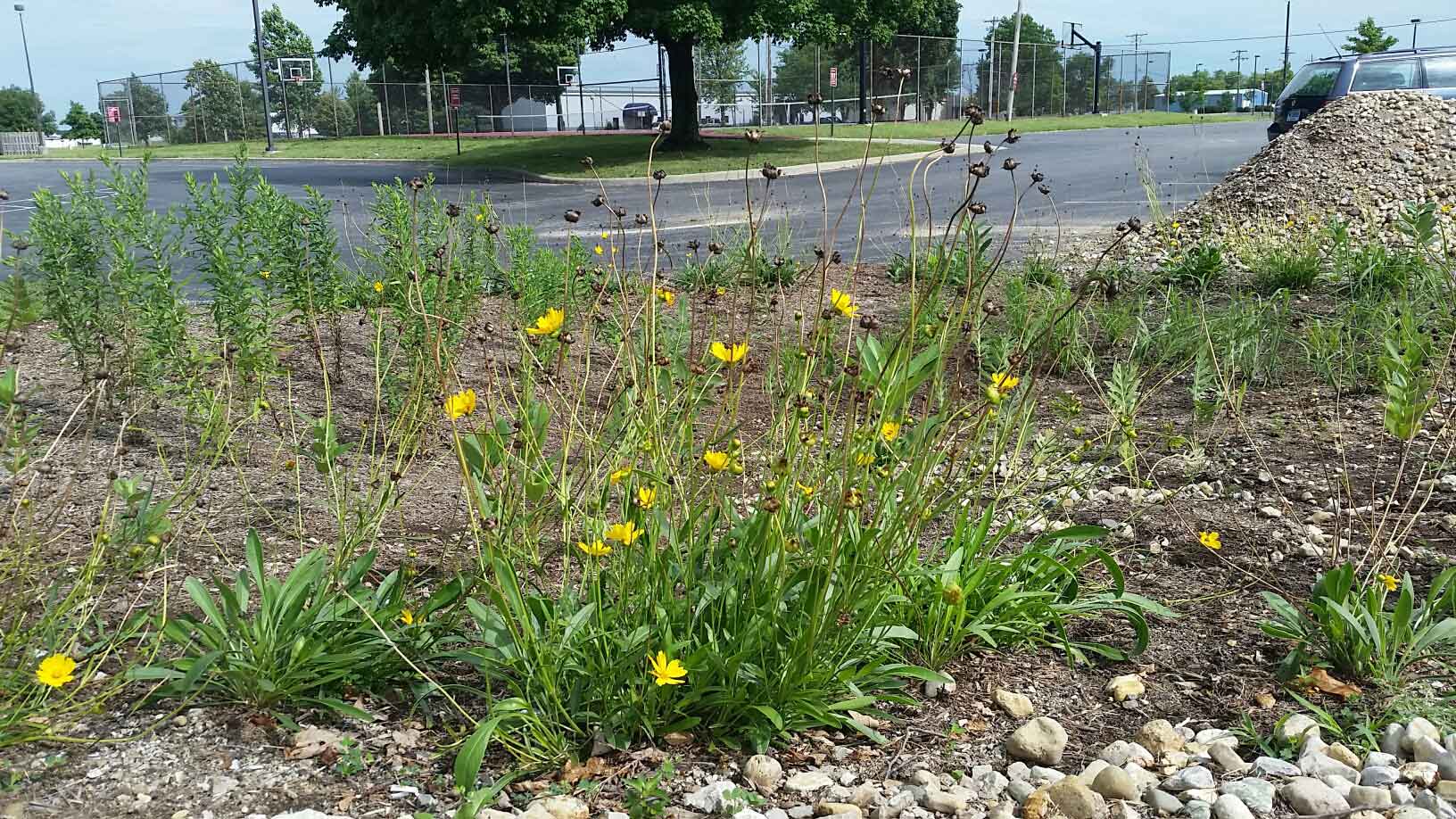 The garden was planted with native prairie plants such as prairie drop seed, big bluestem, and compass plant, and designed by Kris Medic, a Bartholomew Count Extension Educator. Having the right soil composition as well as hardy perennials to fill the garden was an important factor in the design process. It was installed by the Rainscaping education course in Bartholomew County as part of the demonstration garden for the course. Coordinators were able to help with the planting along with the partnership by Indiana University Professors Luke Jacobus and Barbara Hass Jacobus. This partnership was critical to the success of the project and aided coordinators in getting this project off the ground. When the demonstration garden planting day was to start, campus security was concerned about this project going underway, but the partnering professors on campus advocated for the project to be done and the planting day was able to continue.
The garden was planted with native prairie plants such as prairie drop seed, big bluestem, and compass plant, and designed by Kris Medic, a Bartholomew Count Extension Educator. Having the right soil composition as well as hardy perennials to fill the garden was an important factor in the design process. It was installed by the Rainscaping education course in Bartholomew County as part of the demonstration garden for the course. Coordinators were able to help with the planting along with the partnership by Indiana University Professors Luke Jacobus and Barbara Hass Jacobus. This partnership was critical to the success of the project and aided coordinators in getting this project off the ground. When the demonstration garden planting day was to start, campus security was concerned about this project going underway, but the partnering professors on campus advocated for the project to be done and the planting day was able to continue.
The garden has made significant impacts on the campus community and the environment since its opening in September 2015. Having native species on campus provides an oasis of sorts for pollinators and songbirds on a mainly grass and trees campus. Additionally, a killdeer has made the Garden its home, nesting within the site. This site also provides great learning opportunities for student learning in regards to ecology and botany and has created a lot of educational opportunities through positive media attention for the University and school administration.
Background Information
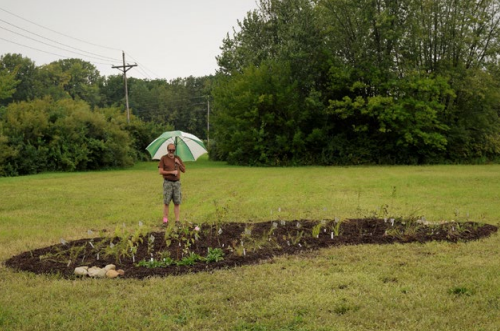 A rain garden was established in 2018 in a portion of the Boone County Community Gardens, on a plot of land offered by the Lebanon Church of Christ. The two acre site is an open field located within Lebanon city limits.
A rain garden was established in 2018 in a portion of the Boone County Community Gardens, on a plot of land offered by the Lebanon Church of Christ. The two acre site is an open field located within Lebanon city limits.
This site was chosen to redirect stormwater and filter it through the soil. As the garden matures, it is expected that this will reduce the water flow into the wet areas of the land. There is a future plan to use the past wet areas a a public vegetable garden. Several Boone County Master Gardeners headed the planning and design portion of the project. Site preparation was done by hand through the work of volunteers. Some plants were extras following the establishment of a Pollinator Garden, while others were purchased by the Boone County Community Garden Organization.
The plants in the rain garden consist of of a mix of sun-tolerant prairie grasses, forbes, and wildflowers. These plants were extras following the establishment of a Pollinator Garden, while others were purchased by the Boone County Community Garden Organization.
Following the installation of the garden, a Boone County Rainscaping Education Team, consisting of seven Master Gardener Volunteers, was formed.
Background Information
The Randall Environmental Studies Center at Taylor University in Grant County, Indiana, has been making efforts towards sustainability for many years, and recently saw an opportunity to turn a lawn in front of the building into a learning opportunity for sustainable stormwater conservation.
With the help of students, community members, Extension Master Gardeners, and more, the 2023 Rainscaping Education Program worked to design and install this rain garden.
With primary excavation and soil amendments performed by Taylor University grounds maintenance staff and environmental science faculty, the ground was formed into a rain garden. Students and participants in the program then planted 120 native plants that are tolerant of wet and temporarily flooded conditions. In addition, this garden is unique in that it also contains several large rocks to serve as teaching examples of Indiana geologic foundations.
Background Information
In September of 2021, a rain garden was established at Purdue Extension Hancock County which is a County office located in Greenfield, Indiana. This was a partnership with the Hancock County Soil and Water Conservation District, Hancock County CISMA, and Hancock County Master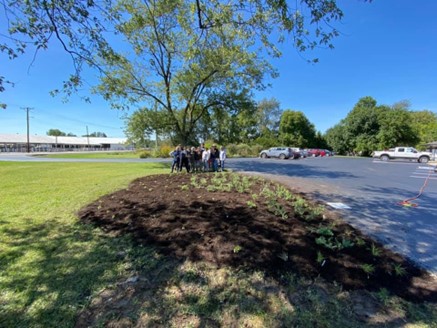 Gardener Association. There is a circle drive and this garden is in the center of that and is situated between the west and east side of the drive. This area was previously a grassy area.
Gardener Association. There is a circle drive and this garden is in the center of that and is situated between the west and east side of the drive. This area was previously a grassy area.
This site was chosen in order to collect some of the stormwater coming from the parking lot pavement in a diffuse method. It is also a site that is visible to the public and will hopefully be used as part of programs offered there and as a conversation piece. This will hopefully decrease the amount of water that stands on the tree roots during rain events. When conducting the infiltration test it was found that the garden drains in 24 hours. The rain garden has an 8” depth center that drains out the back in a diffuse manner as water drains to the nearby ditch. There is also a fairly shaded area so species were selected that could tolerate part shade.
All of the plants are native plants to Indiana and were provided by the Hancock County Soil and Water Conservation District and a Hancock County Master Gardener Association personal donation. Hancock County provided the land. Hancock County CISMA did the site prep. A Hancock County Master Gardener Association volunteer did the tilling. Then the CISMA did the soil and mulch grading labor. There was one planting day with 12 volunteers for approximately 15 manhours to complete planting. Approximately 125 plants were installed in this garden.
Background Information
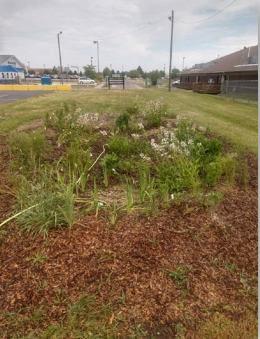 The site was previously a grassy area beside a building and a parking lot.The rain garden is located at the Extension office in Franklin, Indiana. It is visible to the public, but it cannot be seen from the front of the building. The 300 square foot rain garden was installed over one day in September 2019. This site was chosen because it receives runoff from a nearby roof and there are many plants in other areas around the office. Obstacles of the installation included the expenses and the excavation of the site, however each were eventually handled successfully. The rain garden has an ecological impact, as it filters runoff storm water from a downspout. The rain garden also creates a conversation piece.
The site was previously a grassy area beside a building and a parking lot.The rain garden is located at the Extension office in Franklin, Indiana. It is visible to the public, but it cannot be seen from the front of the building. The 300 square foot rain garden was installed over one day in September 2019. This site was chosen because it receives runoff from a nearby roof and there are many plants in other areas around the office. Obstacles of the installation included the expenses and the excavation of the site, however each were eventually handled successfully. The rain garden has an ecological impact, as it filters runoff storm water from a downspout. The rain garden also creates a conversation piece.
This rain garden is home to 236 native plants of twelve different species. All plants were acquired from Spence Nursery, and planted with 12 inch spacing. The garden is weeded by hand every 4 weeks or as needed by EMG volunteers and extension staff. Herbicide was used around the perimeter to keep grass back. No fertilizer was added and the native plants have adapted to the soil type on the site. Sand and compost was added when the initial excavation took place.
Background Information
In November of 2021, a rain garden was established at Ouabache Trails Park which is a County Park located in Vincennes, Indiana. This was a partnership with the Knox County Parks and Recreation Department, Cooperative Invasive Species Management Area (CISMA), and Soil and Water Conservation District. There is a circle drive and this garden is in the center of that and is situated between the Nature Center and their shop area. This area was previously a grassy area and in the past, there was also a small vegetable garden in part of it.
This site was chosen in order to collect some of the stormwater coming from the nature center, shop, and road. It is also a site that is visible to the public and will hopefully be used as part of programs offered there and as a conversation piece. This will hopefully decrease the amount of water that stands on the road during rain events. When conducting the infiltration test it was found that there are two different soil types in the garden area and one drained more rapidly than the other. In order to overcome that the rain garden has a 4” deep pool that slopes down to an 8” pool. There is also a fairly shaded area so species were selected that could tolerate part shade. All of the plants are native plants to Indiana and provided by the Knox County CISMA. The Knox County Parks Department provided the land, excavation, and mulch. There were two planting days with 17 volunteers over both days for approximately 25 manhours to complete planting. Approximately 400 plants were installed in this garden.
La Porte
Background information
In June of 2022, Purdue Extension, Illinois-Indiana Sea Grant, and the City of La Porte worked together to establish a rain garden. It was part of a larger effort to build resilience in La Porte County through the updating of ordinances and installation of green infrastructure. The site is between a parking lot, road, and small park composed mainly of gravel paths with a few flowerbeds.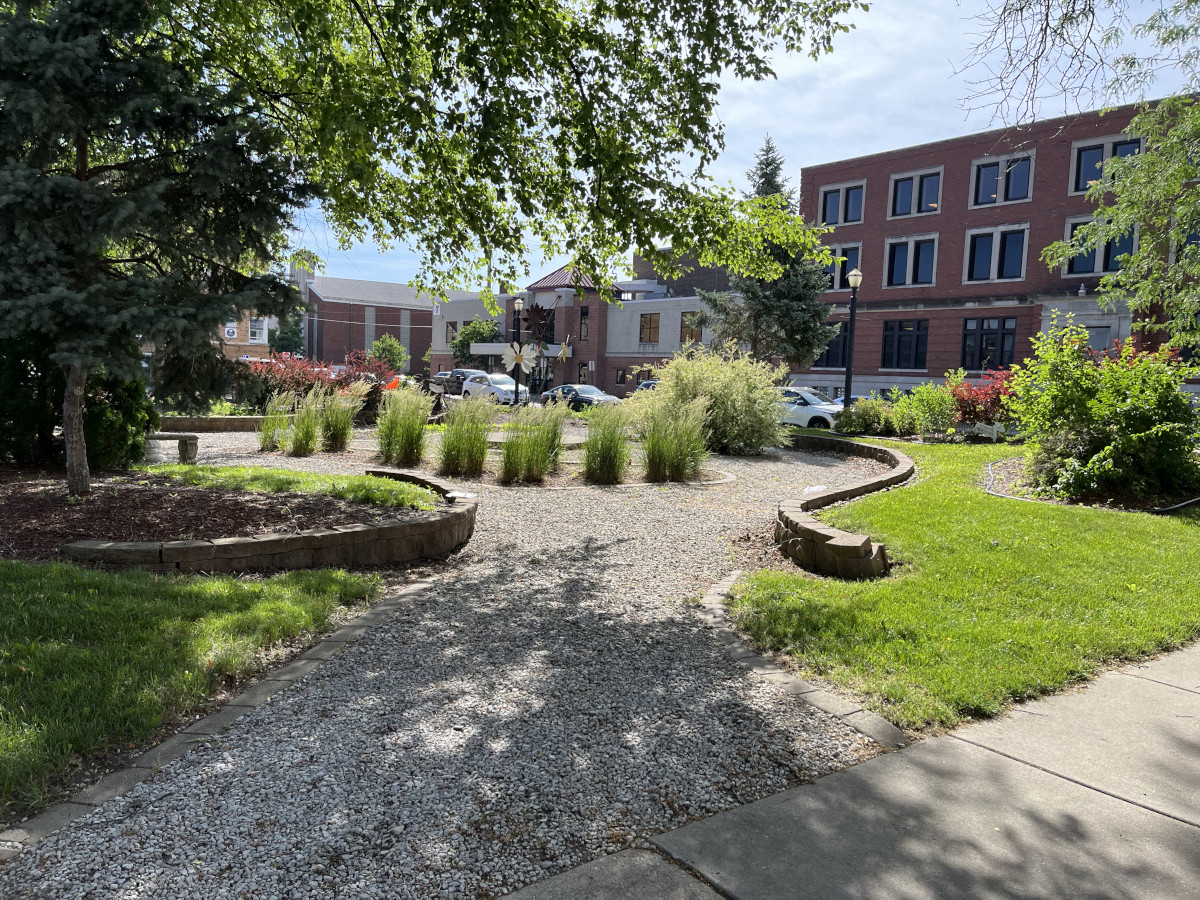
It was chosen because it is a low point between the three areas which generate a significant amount of stormwater runoff. It is also located in a heavily traveled area near Town Hall, giving it great visibility and opportunities to be used educationally. An engineer from the City of La Porte and a local MS4 Coordinator worked with Purdue Extension and Illinois-Indiana Sea Grant to create the design. The site was professionally excavated while the City’s Street and Parks Department worked to further prepare the site with soil amendments and mulch.
There was one planting day with volunteers from the City’s Engineering, Wastewater, Stormwater, and Parks Departments, the La Porte County Library, the La Porte County Soil and Water, the City of La Porte’s Sustainability Commission, and other community members. They first attended an educational session on rainscaping before heading to the rain garden and gaining hands-on experience planting the garden. Only plants native to Indiana were used in the planting. Both shade-tolerant and sun-loving plants were chosen due to trees nearby providing some shade to the site. All plants were suited to handle water conditions within a rain garden.
LA PORTE COUNTY - LA PORTE DEMO RAIN GARDEN (PDF)
Michigan City
Background information
In June 2022, Illinois-Indiana Sea Grant and the SMRT Center worked together to create a rain garden and irrigation system on the property of the SMRT Center. This rain garden is intended to reduce flooding in subterranean levels of the building and increase interest in the site. The irrigation system uses captured rainwater and existing utilities to water the garden beds.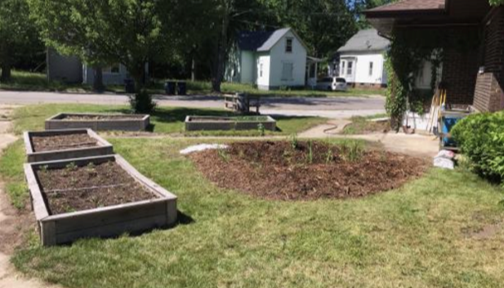
The site is an old fire station with four raised garden beds, some trees and two driveways that intersect the property. The fire station has been converted into a community center that provides senior meals, daycare programs and fresh fruits an vegetables. The site is situated on a triangle-shaped lot in a neighborhood, perfectly placed to engage with the surrounding community.
The project was led by Purdue Extension and Illinois-Indiana Sea Grant in conjunction with Brian Thomas, the lead director of the SMRT Center. This community center operates a garden on the property. An irrigation system designed by Purdue’s Agricultural and Biological Engineering department was installed on the property. This system uses both rainwater and potable water to irrigate the garden beds. The maintenance of the site will be upheld by the SMRT Center and the surrounding community.
Crown Point
Background Information
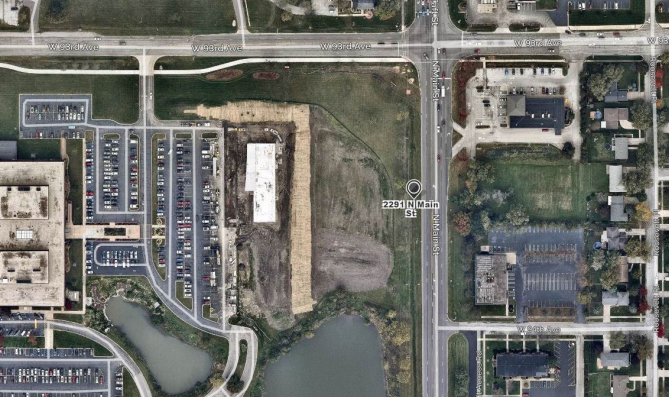 Before this rain garden was implemented, this area was an lower area where water ran through to reach a pond. The water came from gutters of a building and also was directed into a nearby pipe and drain.
Before this rain garden was implemented, this area was an lower area where water ran through to reach a pond. The water came from gutters of a building and also was directed into a nearby pipe and drain.
This area was chosen due to the high levels of flowing water into the pond. The intention was to purify the stormwater and prevent a majority of it from reaching the pond.
Obstacles realized during the creation of the rain garden include the discovery of the poor soil quality in the area. Riprap rocks were discovered underneath the upper level of soil due to erosion from the
northern side of the site and improper maintenance.
The creation of the rain garden allowed for the area to have a more aesthetic appeal. The area suffered from a lack of proper maintenance, which caused it to become visually unappealing. Invasive weeds, tall
grasses, and cattails were removed. Maintenance has become simpler since the installation. The mulch stays in place better due to the application of rocks that block water flow. The plants help with keeping
the soil and mulch in place as well. The plants are healthy due to the water flow. The area also is hoped to improve the water quality of the lake, as much of the water is intercepted by the rain garden.
Lake County – Crown Point Demo Rain Garden (PDF)
Hammond
Background Information
Over the summer of 2022, two structures were built that channel water into a rain barrel that can be used to water an on-site community garden. A rain garden was designed then installed near the rain barrel to capture any overflow. Flowerbeds, a path, and a meditation labyrinth were also installed to create a community space. The site is located on a corner plot of land on the edge of a residential area. Across the street from the site is a set of train tracks, separating the residential area from a commercial area. The site itself has no hookup to city water supplies. This project serves to provide water to the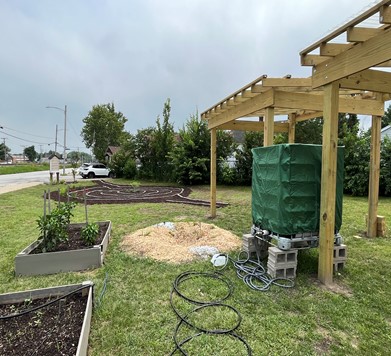 community garden and revitalize the area, thereby countering the effects of redlining in the area.
community garden and revitalize the area, thereby countering the effects of redlining in the area.
The project was led by Illinois-Indiana Sea Grant, through Purdue University Extension, who worked closely with The Gate church. This faith-based group owns the Inner Mission Community Garden and will maintain the site upon completion of the project. Purdue’s Agricultural and Biological Engineering department designed and led the installation of the structures and irrigation system. The Landscape Architecture program created the preliminary design for the path and meditation labyrinth. The City of Hammond issued permits for the structures and provided guidance in understanding local ordinances. Several volunteers from these organizations along with community members also assisted in the implementation of the project, including Purdue University Extension employees in Lake County, Indiana.
Lake County – Hammond Demo Rain Garden (PDF)
Merrillville
Background Information
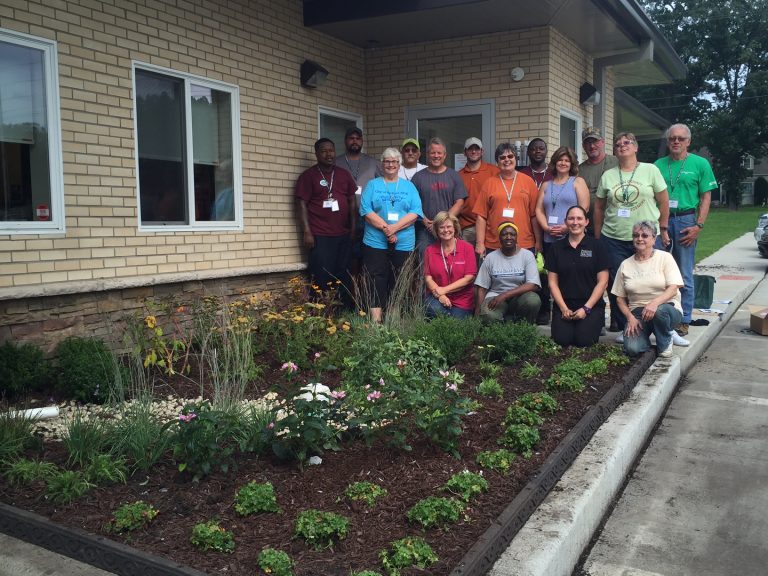
The Merrillville Stormwater Office was designed to showcase features that exhibit responsible practices for stormwater conservation. When it was built, a small area was set aside by the front door for a rain barrel and rain garden. A drain was installed in the area to divert the extra water from the demonstration rain barrel as it was not sufficient to house all of the water that could come off of the roof. After the building was complete, the director, Purdue Extension-Lake County, and the Soil and Water Conservation District collaborated to offer Purdue Extension’s Rainscaping Education Program to educate local residents and conservation professionals about rain gardens and also install the demonstration rain garden on site with the class participants.
The rain garden is a great asset to the area. It provides a more finished feel to the Merrillville Stormwater Office while highlighting a stormwater conservation practice. Furthermore, the garden design highlights a variety of species, which were selected to showcase color in most seasons of the year. The biggest challenge in the garden is the undersized demonstration rain barrel. Therefore, the layout of the rain garden took this into consideration. If the rain barrel were to heavily overflow, there is a straight path of rocks to the drain so that the plants do not wash out. Additionally, plants around the edges of the bed were chosen to hold water in the bed and prevent mulch from washing out.
This successful demonstration garden is visibly placed next to the stormwater building front door to highlight the mission of the office while also displaying how rain gardens can be both functional and attractive.
Background Information
Indy Urban Acres (IUA) is an 8-acre urban farm located on the East side of Indianapolis and funded by a local foundation that supplies primarily lower-income Hoosiers with healthy fruits and vegetables and services one of the area’s largest food deserts. The site is also a green space for local neighbors and a learning space. In 2014 the farm constructed a small 300-square-foot rain garden to handle drainage from a nearby greenhouse as well as the field area to the north. Several mature native stands of Blue Flag Iris and Flat-Topped White Aster as well as Grey Dogwood shrubs have survived from the garden’s original planting but over time due to local weed pressure from the nearby highway and surrounding area the garden became dominated by the following invasive species: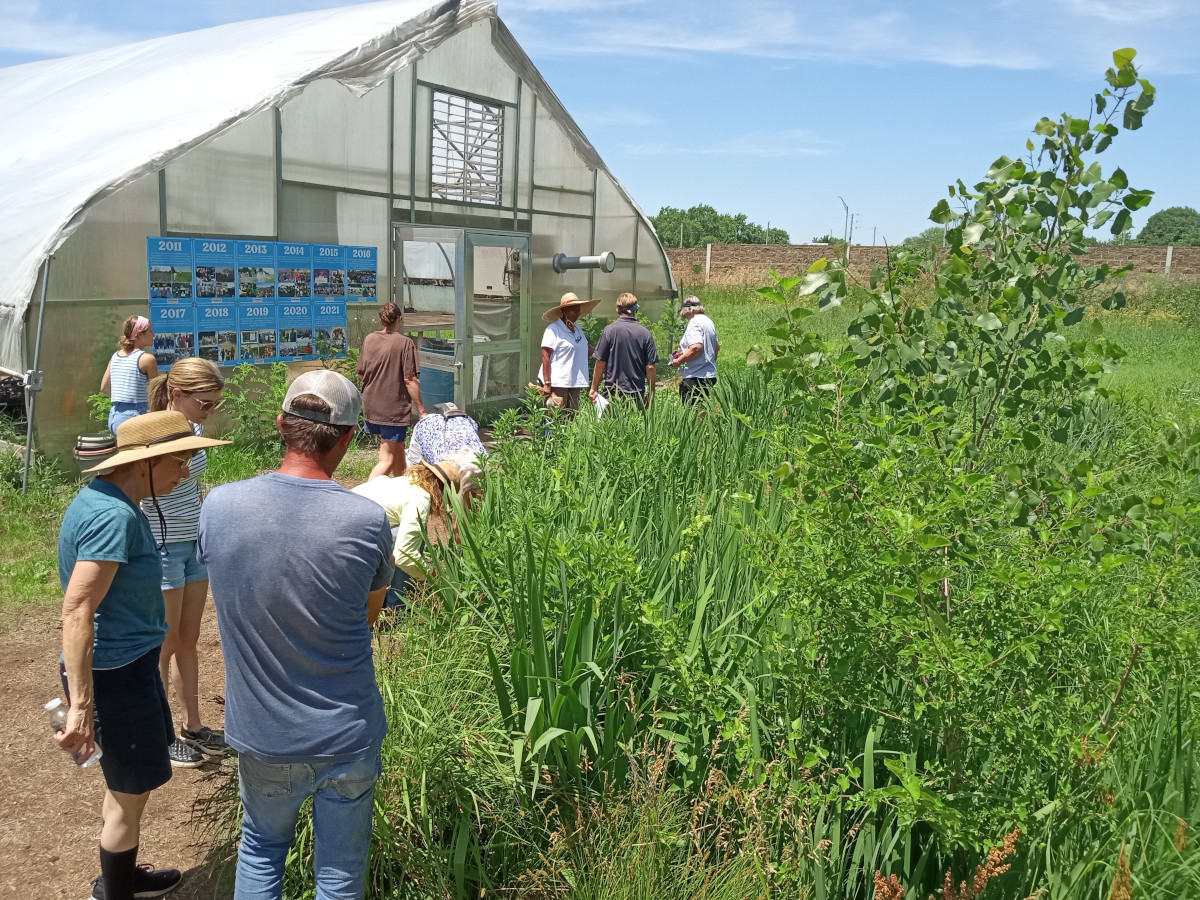
- Canada Thistle
- Prickly Lettuce
- Curly Dock
- Plantain
- White Mulberry
- Siberian Elm
- Bush Honeysuckle
In addition to the invasives listed above, the limited infiltrative capacity of the native Crosby soil was compromised by dumped potting soil and other sources of contributing sediment from adjacent farmed areas. After performing a simple 24-hour infiltration test which determined the saturated soils could infiltrate at least 4.5” in a 24-hour period, areas were identified for new plantings that included graminoids (grasses and sedges) since the rain garden was dominated by forbs and invasives and needed greater diversity to meet the 70% forbs/30% graminoid planting goal recommended for rain gardens.
The Rainscaping workshop demonstration project work restored the functionality of the garden and included the removal of the various invasives listed above and newly cleared areas were planted with approximately the following native species: Obedient Plant, Prairie Dropseed, Palm Sedge, Bee Balm, and Joe Pye Weed. Obedient Plant and Bee Balm were selected for their aggressive growth habits and Joe Pye Weed was intentionally planted in the center of the garden due to its height. The graminoids were interspersed in drifts to meet the goal of 30% grasses/sedges in the planting mix due to their root structure and ability of these low-statured plants to reduce weed pressure. Mulch was also added to the new plantings with an in-kind value of approximately $20 for mulch and $350 for the plant material. All participants were able to select 24 native plugs from the greenhouse for their individual plantings as well.
The rain garden is a small demonstration garden behind the Albion branch of the Noble County Public Library. The rain garden may diminish flooding in certain areas of the property. Additionally, this rain garden could reduce salts and other pollutants from the nearby parking lot through filtration. This site on the property was also chosen because the location is highly-visible from inside the library. This 300-square foot garden will serve as an educational tool, in spiring others to consider installing their own rain garden.
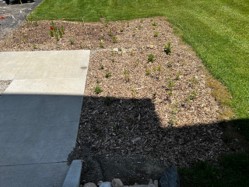 Due to a large rain event two days prior and another rain the night before, installation happened in two parts. The first installation was completed by Rainscaping Education Program participants and the second half was completed by the Noble County Master Gardeners on a later date.
Due to a large rain event two days prior and another rain the night before, installation happened in two parts. The first installation was completed by Rainscaping Education Program participants and the second half was completed by the Noble County Master Gardeners on a later date.
Funding and support for the project included the Noble County Master Gardeners, the NIPSCO Environmental Action Grant, the Amelia Frehse Charitable Trust Grant, and Friends of the Noble County Public Library. Plants were donated by Purdue Extension Master Gardeners, Blue Fox Farms, and Blue River Native Nursery. OnSite Tree Services donated the site prep work and mulch.
Background Information
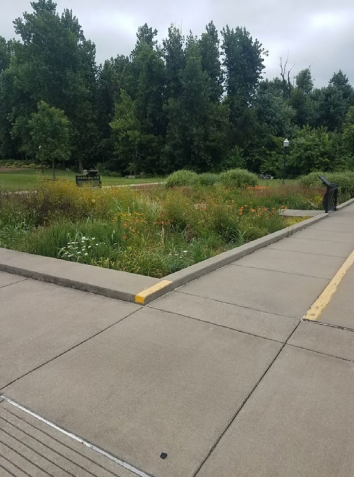 The current rain garden was previously a site for another, poorly maintained rain garden. The improved rain garden is located on a riverfront walkway with an outlet that leads directly to the Ohio River.
The current rain garden was previously a site for another, poorly maintained rain garden. The improved rain garden is located on a riverfront walkway with an outlet that leads directly to the Ohio River.
This location was selected because it provided a convenient rain garden for refurbishment. This created an ease of access and use.
Challenges discovered during the improvement of the previous rain garden included the size of the garden in regard to the people available to maintain it. The size of the rain garden was far too large for a dozen people to rehabilitate and maintain, therefore the size of it was scaled down to accommodate those that would maintain it over time. Additionally, the plant selection of the new garden was not well communicated, but the final project came together very nicely.
Currently, the reinvigorated Master Gardeners maintain the garden. It receives a lot of foot traffic. There is educational sinage that is easily visible for visitors. Not only is the rain garden a source of education, but it also is ecologically beneficial for filtering water that drains into the Ohio River.
Background Information
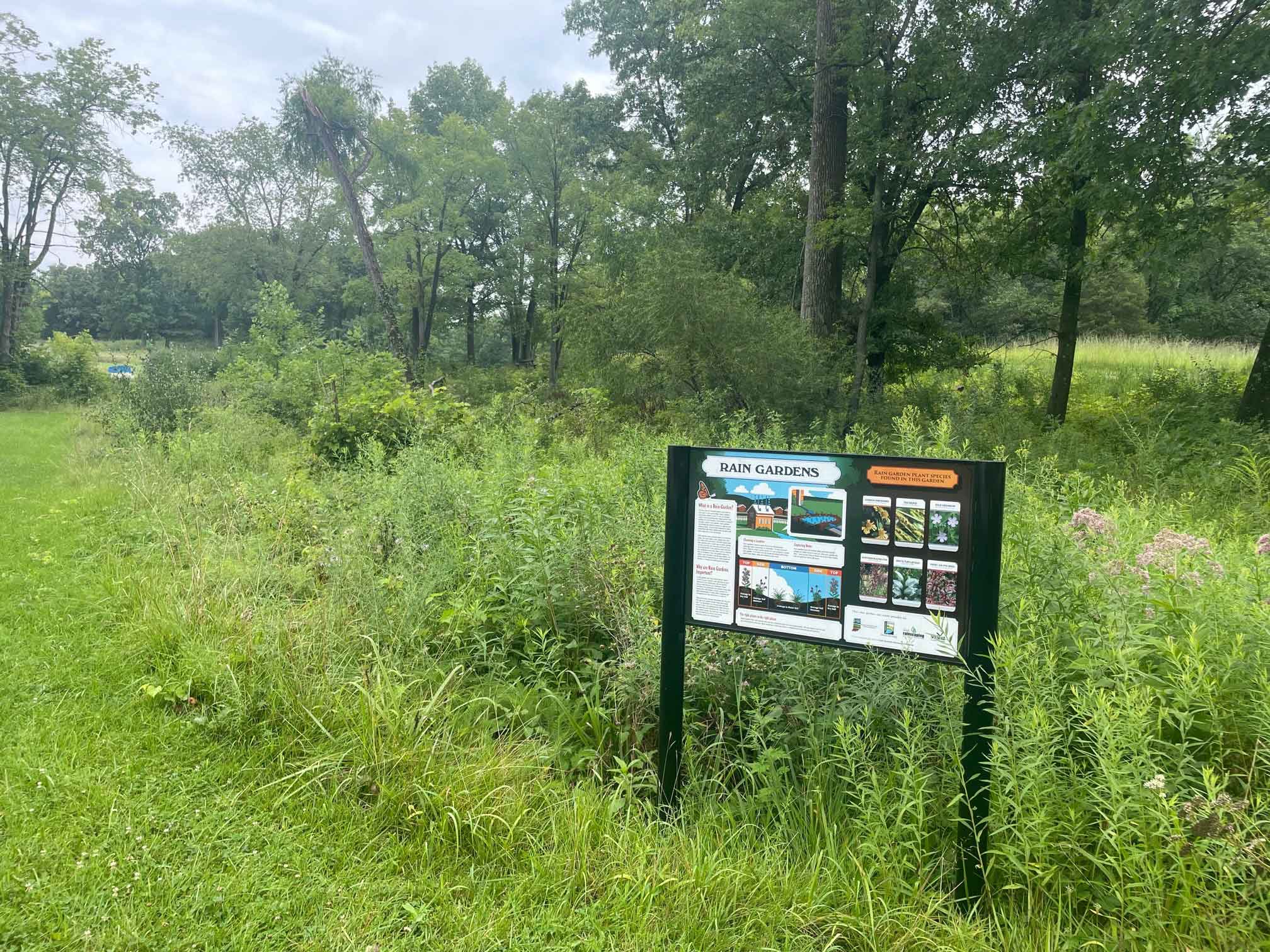 This rain garden was created in a grassy area near the Wild Turkey Shelter, which is located in a 3,000 sq ft acre of wildland and recreational area. This area was chosen because there is a drainage pipe directly in front of it that releases water near Gentian Lake. This rain garden could aid with reducing pollutants through filtration.
This rain garden was created in a grassy area near the Wild Turkey Shelter, which is located in a 3,000 sq ft acre of wildland and recreational area. This area was chosen because there is a drainage pipe directly in front of it that releases water near Gentian Lake. This rain garden could aid with reducing pollutants through filtration.
Immediately before installation occurred, the area received a large amount of rain. It had rained six inches in three weeks; therefore, the installation was delayed so the area could dry. Erosion was reduced by adding straw blankets during installation and large rocks were placed in the middle due to higher rates of water flow. The rain garden in this case mostly has an ecological impact, as the primary goal is to filter pollutants from entering the nearby lake.
Tippecanoe County Extension Office
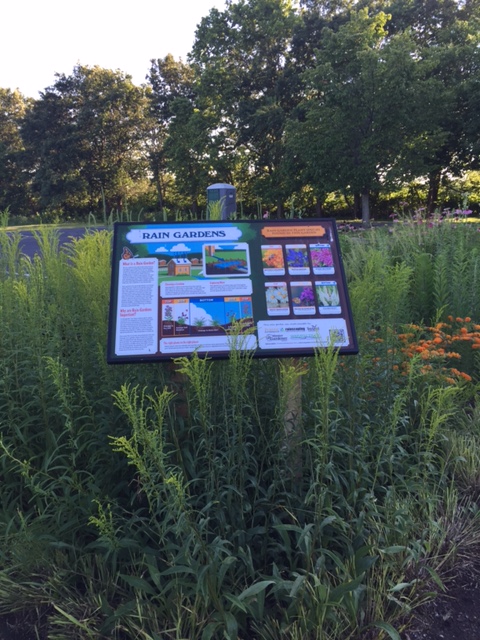
At the Tippecanoe County Extension Office, the community saw a parking lot island as an opportunity for reducing runoff and increasing green space in the area. This site allows for a 500 square foot rain garden split into two gardens surrounding the path. With a prime location for viewing and accessibility as well as the effectiveness of capturing stormwater runoff, the installation of this rain garden went underway following the steps of the Purdue Rainscaping Education Program. This site allows for easy viewing access to visitors and also an excellent example of the benefits of Rainscaping.
Utilizing a landscape design and installation company, the area’s soil was treated and shaped to prepare for the rain garden. Soil amendments were added, and the land was formed to add a depression to allow for water to drain into the garden. The participants of the course planted native plants tolerant of a 24 hour flooding period as well as other hardy and easy to maintain perennials such as blue false indigo, bottle brush grass, and bottled gentian.
A year later, the rain garden is growing successfully and beautifully. It takes the runoff from the Tippecanoe County Extension Office Building and surrounding parking lot and prevents those pollutants from running off to near water sources making the rain garden an excellent example of Rainscaping.
Wright Center
Background Information
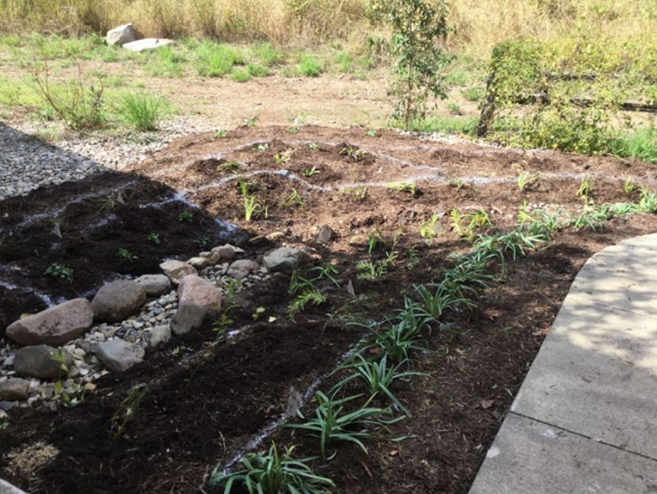 The Wright Center Rain Garden was established in 2017. The garden is located in the courtyard of the John S. Wright Conference Center. The Wright Center is located in West Lafayette, IN and is managed by the Purdue University Department of Forestry and Natural Resources (FNR) for teaching and research.
The Wright Center Rain Garden was established in 2017. The garden is located in the courtyard of the John S. Wright Conference Center. The Wright Center is located in West Lafayette, IN and is managed by the Purdue University Department of Forestry and Natural Resources (FNR) for teaching and research.
Prior to the rain garden, the courtyard of the conference center was underutililized and needed landscaping updates. This rain garden was constructed as part of the 2017 Rainscaping Education Train the Trainer Program for Extension Educators. Purdue FNR staff completed the siting, sizing, and design of the rain garden. The area was selected as an exemplary area for stormwater management education. The garden is 300 square feet and 12” deep. It has an interpretive sign located in the glass hallway in front of the rain garden for visitors to learn more.
Background Information
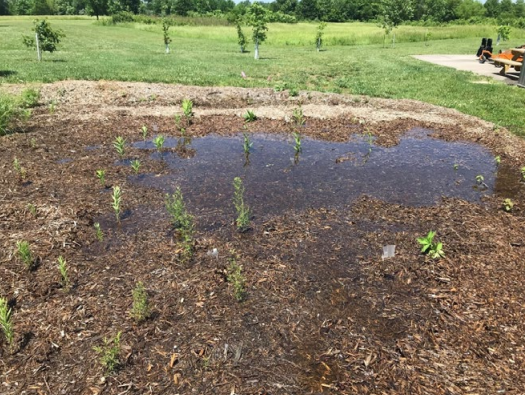 The site was previously a grassy area beside a building and a parking lot. The raingarden is located in Friedman Park in Newburgh, Indiana. This site was chosen because it receives runoff from a nearby roof. The rain garden has an ecological impact, as it filters runoff stormwater.
The site was previously a grassy area beside a building and a parking lot. The raingarden is located in Friedman Park in Newburgh, Indiana. This site was chosen because it receives runoff from a nearby roof. The rain garden has an ecological impact, as it filters runoff stormwater.
This rain garden is home to 133 native plants of fifteen different species. All plants were acquired from Dropseed Nursery, and planted with 18 inch spacing. The 480 square foot rain garden was in-stalled over one day in August 2018. Over the course of 24 hours, the rain garden can drain a total of 5.5 inches of water standing water per day
Illinois
Background Information
In October of 2021, a rain garden was established at the University of Illinois Extension Office located in Effingham, Illinois. This was a partnership with the Effingham County Master Gardeners, Watershed Outreach in the Illinois Nutrient Loss Reduction Strategy with Illinois Extension, and Effingham County Extension. There is a large sloped parking lot at the Extension office in Effingham that leads to an area that is wet most of the year.
This site was chosen to collect some of the stormwater coming from the Extension office and slow its progression to the wet area. It is a site that is visible to the public and will be used for educational and teaching programs as well as a conversation topic. This should decrease the amount of water that sheets off the parking lot into the wet area during rain events. The infiltration test revealed one basic soil type in the area which allowed water to move quickly across the ground to the wet area. To overcome this, the rain garden slopes from level ground to a 6” deep trough. The area receives full sun. The plant species were selected for full sun tolerance.
All plants are native to Illinois and purchased from Southernwood Gardens, a native plant grower and nursery, located in Alto Pass, Illinois. Two types of hardwood mulch, regular and doubled ground, were purchased from a local vendor, Heartland Landscaping, Inc. in Effingham. Plants and mulch were provided by University of Illinois Extension - Effingham County. Mycorrhizal inoculum was added at the time of planting and provided through grant funds. Site excavation was provided by the Josh and Amy Tegler family. One planting day was selected with three Master Gardeners, one volunteer, and two University of Illinois Extension staff. Approximately 100 plants were installed in this garden.
Background Information
In the fall of 2022 University of Illinois Extension partnered with Historic Nauvoo to present the Purdue Rainscaping proram. Prior to the course, horticultural staff for Historic Nauvoo worked with Illinois Extension to identify suitable locations to install a rain garden. The site selected features two linear sections along a roadway at the intersection of Hyde and Hotchkiss street.
The existing conditions of the site was a graveled ditch. Due to the site's capacity to infiltrate stormwater and high visibility, the team decided this was an ideal location for a rain garden.
Water flow comes from the adjacent street flowing north to south, through a connecting culvert at the intersection and then east to west. These rain gardens function more like a bioswale, conveying water while slowing it down and allowing for more infiltration with increased friction from plant material.
The Historic Nauvoo horticulturist worked closely with Illinois Extension in the planning, design, preparation, and installation of the rain garden.
Historic Nauvoo has an estimated 100,000 visitors each year. This location is prime for educational efforts of how green infrastructure can serve to reduce the impact of flooding.
Illinois Extension received a grant from the Extension Disaster Education Network (EDEN) for green infrastructure projects to support the purchase of plants and mulch.
Background Information
In August of 2019, a rain garden was established at the University of Illinois Extension Office located in Murphysboro, Illinois. This was a partnership with the Jackson County Master Gardeners and Jackson County Extension. There is a large sloped parking lot located at the Extension office in Murphysboro that leads to an area of surrounding turf and research plots.
This site was chosen to collect storm water exiting the Extension office parking lot, slow its progression to the surrounding turf and research plots, and allow for infiltration of the collected stormwater into the ground layers. It is a site that is visible to the public and will be used for educational and teaching programs. The garden should decrease the amount of water that sheets off the parking lot into the research plot area during rain events. The rain garden is an unlined bio-filtration basin. The area was amended down to a depth of 18” with an engineered bio-retention media consisting of 70% landscape sand, 15% compost, and 15% native soil. The area receives full sun. The plant species were selected for full sun tolerance.
The garden was planted with a range of native forbs and sedges designed to bloom throughout the growing season and create a deeply rooted dense planting. The plants selected help to slow down and infiltrate stormwater run-off, resist water stress, and attract pollinators. Mycorrhizal inoculum was also added to increase the symbiotic fungal activity between the soil and plan root ecosystem. Approximately 300 plants were installed in this garden. All plants are native to Illinois and were purchased from Pizzo Native Plant Nursery, located in Leland Illinois. Sand and compost were purchased from Burkdell Mulch, located in Carbondale, Illinois. Mycorrhizal inoculum was obtained from an online source, horticulturesource.com. A standard drip tape kit was purchased from dripdepot.com. A 32 excavator was rented for one day from Ace-Just Ask Rental, located in Carbondale, Illinois.
BACKGROUND INFORMATION
In May of 2024, a rain garden was established at the University of Illinois Extension Office located in St. Charles, IL. There is a grassy area between two sections of parking lot, bounded by a ditch with sharply sloped sides on one end and the Kane County Fairgrounds on the other side. This area of grass is in full sun, frequently wet and the ditch has continuous flow for most of the year.
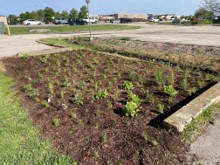
This site was chosen to help mitigate the stormwater flow from impervious surfaces at the Fairgrounds and Extension office while also improving the appearance of the area. There was already a gentle slope on all sides, creating a sort of “bowl” shape which directed water to the ditch. This site is visible to the public and Randall Rd. and will be used for educational purposes, as well.
The site was mulched with regular, double-ground hardwood mulch from a local vendor. Plants were selected from Midwest Groundcovers, a local nursery with a native plant division, who also donated a number of plants for the project. All plants are native to the region. Plants were installed by the 17 students who were part of a Rainscaping classed offered by Extension.
Background Information
Riverside Rain Garden is a small demonstration garden that is part of a larger park plan. Done in partnership with the City of Moline, the rain garden is located next to the park building, a highly visible location. Water from the building is diverted into the garden. An existing sidewalk provides easy viewing for park visitors and easy access to an educational sign referencing the garden.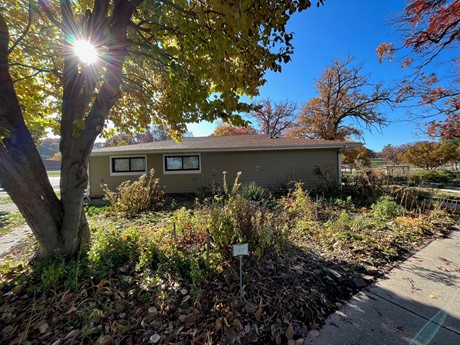
Illinois Master Gardeners and Illinois Master Naturalist partner with Friends of Riverside to maintain a few planting beds within the park. The rain garden will be maintained as an Illinois Extension project.
The planting plan was derived from a recommended plan developed by the University of Illinois Red Oak Rain Garden. Plant growth and garden development will be documented, and data will contribute to the study of those plans as they continue to be improved.